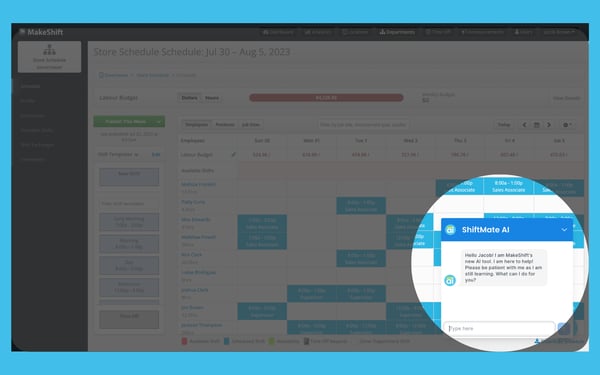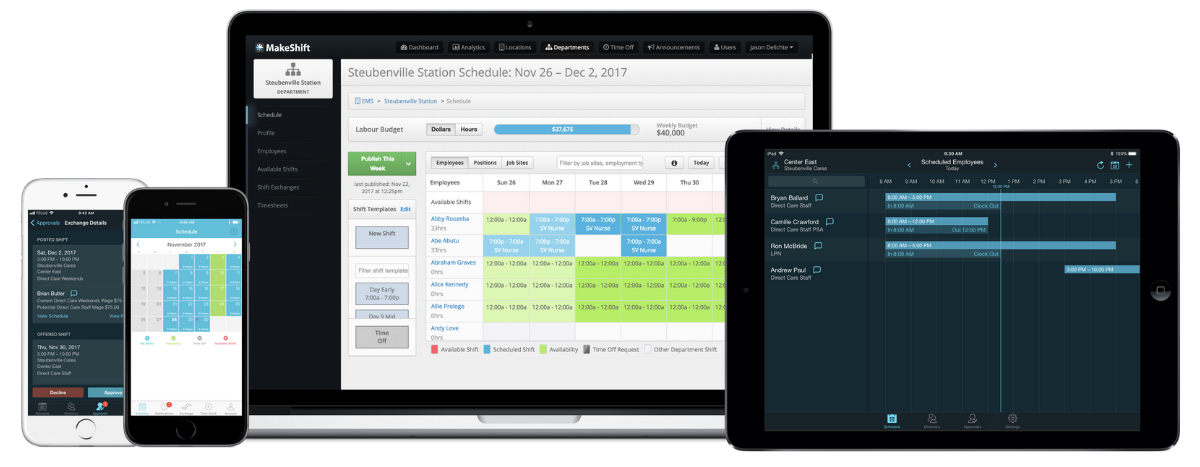“Better safe than sorry.”
Once upon a time, that could’ve been your business mantra. Understaffing creates such a nightmare that you might have over-hired and over-staffed just to cover your bases.
While understaffing may look like frenzied chaos, an overstaffed business looks like things are moving at sloth speed.
Overstaffing can create chronic boredom, drain employee motivation, and, ultimately, may cause you to lose valuable talent.
With the technology available today, overstaffing isn’t necessary.
When you’ve got access to software that accounts for past staff schedules, business insights, and current employee availability, scheduling can be smarter and more accurate than ever.
In a fraction of the time.
Today, we’re talking about how to spot and stop overstaffing. And offering solutions for thought leaders interested in business growth and exceptional employee experience.
- What Is OverStaffing?
- What Causes Overstaffing?
- 3 Problems that Stem from Overstaffing
- How to Prevent Overstaffing
- MakeShift Helps Prevent Overstaffing
- Overstaffing FAQs
What Is OverStaffing?
Overstaffing happens when a company has more employees working than it needs to complete the work. This can happen for reasons like:
- Poor scheduling
- Unclear workforce planning
- A rapid change in customer demand
- Seasonal variations
The retail industry particularly struggles with overstaffing, especially after Covid.
Walmart and Amazon reported being overstaffed after the first quarter of 2022, which has led to layoffs in 2023.

Retailers announced nearly 56,000 job cuts through the end of August 2023, a shocking 524% increase compared to last year.
What Causes Overstaffing?
Overstaffing can burden businesses, leading to unnecessary expenses and inefficiency. We’ve addressed 3 common reasons behind this problem.
Do you grapple with overstaffing?
One or more of these issues might be your problem…
1. Not using online tools to track time & schedule your employees
Many businesses struggle with overstaffing due to inefficient employee management tools.
It can be challenging to match staffing levels to actual demand without modern time tracking and scheduling software. This can leave you with too many employees on the clock when the workload doesn't warrant it.
2. Overhiring a team due to improper forecasting
Inadequate forecasting is a significant contributor to overstaffing. Some industries, like retail, often hire more workers than needed, especially during peak seasons, without considering long-term staffing requirements.
This results in surplus workers during quieter periods.
3. Overcompensating for demand
In certain industries, there’s a tendency to overcompensate for fluctuating demand. Companies may hire extra staff to ensure they can handle peak periods but may not adjust their staffing levels effectively during slower times.
This can lead to overstaffing, which can be costly.
Not only can overstaffing impact your bottom line, it can cause big problems among your staff.
3 Problems that Stem from Overstaffing
Overstaffing can damage your employees’ well-being and your company culture.
Here are the top 3 problems that stem from overstaffing your workplace.
1. Unwanted Time Off
The point of working is to make money — cash for the rent, bills, and maybe a little fun. While scheduled time off can be an opportunity to recharge, excessive unwanted time off can cause stress, concern, and financial instability for your staff.
There are 2 types of unwanted time off:
- Type 1 — Last minute callouts/ Absenteeism — If employees don’t feel needed at work, it could lead to chronic boredom. When this happens, they may call in sick for shifts or just not show up because chronic boredom can be just as bad as burnout from understaffing.
They’ve got a name for chronic boredom at work — boreout. And it can affect your employees by causing:
- Stress
- Anxiety
- Depression - Type 2 — Getting benched — The manager sends staff home because there’s not enough work for everyone. This leads to less pay, low morale, and eventually, probably losing the employee.
2. Morale’s in the toilet
While we all love some downtime, too much can suck the life out of us. And an overstaffed workplace is a surefire morale killer.
Employee morale is the outlook, attitude, contentment, and confidence your team members have at work. It’s also a reflection of your company culture’s health.
When employee morale is low, you’ll have:
- Absenteeism
- Low engagement
- No motivation
- Negativity
And unfortunately, where there’s low morale, you can bank on increased time theft.
Bored employees stare at the wall, watch videos on their phones, and take naps in the bathroom, all while on the clock.
3. Productivity has plummeted
Employees don’t feel engaged without enough to do — they tend to drift like a weathered piece of wood floating aimlessly down a river.
Overstaffing leads to boredom and low morale, the sworn enemy of productivity.
Employees who don’t feel challenged, engaged, and valued at work won’t take ownership of their role — you’ll see it in your overall productivity.
If you’re in retail, you’ll notice messy shelves and stacks of unpacked boxes of inventory — the basics of any retail floor worker’s job, going undone.
If you feel it’s like pulling teeth to get most of your team to do the bare minimum, you probably need to examine your staffing situation.
How to Prevent Overstaffing
Overstaffing doesn’t have to be part of your business. You can prevent it with proactive steps that’ll address staffing as well as overall efficiency.
1. Use Scheduling Software
Adopting staff scheduling software will give your scheduling process a complete overhaul. Not only can it help prevent under or overstaffing, but it can also provide real-time insight to help optimize your workforce.
A stellar staff scheduling solution allows for:
- Demand forecasting — Scheduling software uses historical data and predictive analytics for accurate workforce forecasting. This helps you schedule the right number of employees to match the expected workload, preventing overstaffing during slower periods.
- Real-time Monitoring — Real-time visibility into employee schedules and workloads allows managers to adjust staffing levels on the fly. This enables them to avoid understaffing when slammed and overstaffing during quieter times.
- Automation and optimization — You can automate the scheduling process and optimize staff allocation based on workload and employee availability. As the software considers all relevant factors, you're less likely to schedule too many employees for a shift inadvertently.
- Alerts and notifications — Some scheduling software offers alerting features that notify managers when staffing levels are trending toward overstaffing. This proactive approach allows for quick adjustments to maintain an optimal staff-to-workload ratio.
2. Flexible Scheduling
Develop flexible scheduling options that allow for adjustments based on real-time demand.
- Utilize on-call or temp staff for variable workloads to avoid overhiring
- Adjusting hours based on demand
Let’s look at a few examples to illustrate how industries use flexible scheduling options to manage their workforce based on fluctuating demand, preventing overstaffing and optimizing resources.
- Retail Industry
On-call staff — During busy seasons like holidays, employ on-call staff. These employees are scheduled based on real-time demand. For example, if a store experiences a sudden rush of customers, on-call employees are called in to handle the increased workload.
Temp workers — Hire temporary workers for seasonal fluctuations, like hiring extra sales associates during Black Friday weekend. - Restaurant Industry
Variable shift length — Adjust the shift length for waitstaff, cooks, and other employees based on reservation and foot traffic. Employees work longer shifts when it's busy, while less staff is scheduled during quieter times.
On-call servers — In upscale restaurants, use on-call servers. If reservations exceed expectations, call in your on-call staff to provide additional support. - Healthcare Industry
Per diem nurses — Hospitals can employ per diem, aka “on-call” nurses, to address unexpected patient surges. These nurses aren’t on a fixed schedule and can be brought in only when patient volumes rise.
Flexible shifts for support staff — Adjust support staff shifts, like cleaning and maintenance personnel, based on patient occupancy. This helps prevent overstaffing during periods of lower activity. - Hospitality and Hotels
On-call housekeeping — Employ on-call housekeeping staff that aren’t regularly scheduled. When many rooms need to be cleaned quickly due to check-outs and new reservations, on-call staff can be called in to assist.
This can work great for people with flexible schedules looking for a side hustle.
Variable Bellman Services — Hotels can adjust the number of hotel porters or valet staff on duty to align with check-in and check-out times. This provides a better guest experience during peak hours and prevents overstaffing during slow hours.
You might be surprised how many employees would jump for a more flexible schedule.
In a Skynova study, over 36% of surveyed employees valued their flexible schedule over PTO, and almost half said having a flexible schedule trumps their salary.

3. Employee Self Scheduling
Some flexible scheduling systems let employees choose their shifts or work hours within specific parameters. An employee self-scheduling system eases your burden of shift planning and schedule creation by empowering your staff to set their schedule.
This can help align staffing levels with employee availability and preferences, reducing the risk of overstaffing while making your staff happy.
4. Regularly Review and Adjust
Continuously monitor your staffing levels and adapt as needed. Be prepared to make schedule adjustments based on your changing business needs.
Be sure to communicate REGULARLY with your staff and ask for feedback.
5. Cross-Training
Cross-train employees in multiple roles to optimize resource allocation.
This allows for more flexibility and better distribution of tasks during fluctuations in workload.
Cross-training employees in various roles enables them to jump in where needed.
This flexibility in task assignments prevents overstaffing in one area while another is short-staffed.
Do you cross-train your employees?
If not, your retention rates are in danger.

Because 70% of employees would abandon ship for a new employer that provides better access to L&D opportunities.
By spotting the signs of overstaffing, understanding its impact on staff, and taking preventative measures, you can achieve a more balanced and efficient staffing model that benefits your team and business.
How MakeShift Helps Prevent Overstaffing
At MakeShift, our number 1 priority is smarter, streamlined scheduling that’s good for your employees and your business. We developed our people-centric software to simplify scheduling more accurately and intuitively.
MakeShift can help prevent overstaffing through:
- Streamlined scheduling efficiency — Quickly create and modify schedules based on staffing needs. You’ll be able to manage your staff levels better and allocate resources more effectively.

- Efficient communication — MakeShift scheduling includes communication features like messaging and alerts, which let you quickly communicate with your team and keep them informed about schedule changes or staffing needs.

- 24/7 Scheduling assistance — Create schedules at 2 a.m. if you want, with the help of our AI-powered scheduling platform, ShiftMate AI. It responds in real-time to your queries, provides step-by-step instructions, and offers scheduling tips. It's the support you need right as you need it.

- Enhanced employee engagement — Employees can view their schedules, request time off, fill open shifts, and swap shifts with their colleagues. This can help improve employee engagement, reducing burnout and the revolving door of employees.

- Data-driven insights — Reporting features allow you to track employee productivity, attendance, and other metrics. This can help you identify areas for improvement and make informed decisions about staffing levels and scheduling needs.

- On-the-go accessibility — MakeShift scheduling is accessible from any device with an internet connection, allowing you to manage your workforce from anywhere. Quickly respond to staffing needs and manage your employees on the fly.

- Your employees will LOVE having their schedules in their pockets.

Overstaffing FAQs
What are the signs of overstaffing?
Recognizing the signs of overstaffing is vital to preventing it in the future. Look for these signs at your workplace: idle employees, high labor costs, decreased productivity, and increased absenteeism.
How do you fix overstaffing?
To address overstaffing, first review workloads and assess staffing requirements to ensure they align with actual demand. Implement flexible scheduling options, like on-call staff, to adapt to varying demand levels. Natural attrition can be an option. Avoid immediate replacements for departing employees unless essential. Cross-train employees to perform multiple roles to maximize their utility during fluctuations in demand.
What are the results of overstaffing?
The consequences of overstaffing are higher costs, as excessive labor expenses can impact your organization's profitability. Morale among overstaffed employees tends to decrease as chronic boredom sets in. This inefficiency can lead to a reduction in overall productivity, and resources that could have been invested in growth or improvements are instead tied up in excess staffing, potentially resulting in missed opportunities for the company.
Overstaffing Is Preventable
Technology has opened the door to better workforce management with more insight, better predictability, and scheduling flexibility.
You don’t have to over-hire, over-schedule, and over-staff in hopes of covering shifts. Staff scheduling software allows you to schedule smarter and streamline your processes and costs.
Ready to get proactive when it comes to scheduling? Schedule a free demo today to see what MakeShift can do for you.








